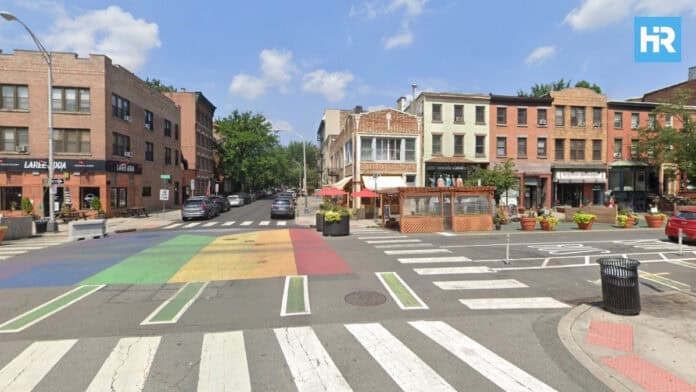Jersey City is changing the way cities grow and connect.
With a focus on better public spaces, eco-friendly transportation, and fair access for everyone, the city is becoming a model for modern urban living.
Thoughtful changes like these make Jersey City a more welcoming, enjoyable, and sustainable place for people to live, work, and visit.
- Jersey City has built 25 miles of bike lanes, planted 1,000 trees, and redesigned areas to create parks and plazas.
- Over half of residents walk, bike, or take public transport, shifting toward greener commuting options.
- Programs like bike-sharing and rideshares are helping low-income and minority communities get around easily.
A Fresh Start with New Ideas
Two years ago, Jersey City established its Department of Infrastructure, a move many called groundbreaking for a city of size.
For the first time, the city brought streets, parks, transit systems, and public buildings under one department, which has allowed the city to see everything as part of one big plan instead of treating projects as separate pieces.
And the changes came fast.
The city built nearly 25 miles of protected bike lanes so cyclists could ride safely without worrying about cars.
They also redesigned areas once filled with cars and asphalt into public plazas where people can gather, relax, and enjoy the city.
Over 1,000 trees were planted, which not only made the city greener but also helped the environment.
Plus, new parks and parklets popped up everywhere, and people now have more places to eat, play, and take a break.
Big Plans for a Greener Future
Jersey City didn’t stop with bike lanes and trees.
The city developed big plans, such as the Bicycle Master Plan, Pedestrian Enhancement Plan, and Vision Zero Action Plan.
They also launched the Greenway Connectivity Plan, which links neighborhoods with paths for walking and biking, and the Complete Streets program to make roads safer for everyone.
And the numbers show it’s paying off.
Today, 57% of Jersey City residents walk, bike, or use public transit for their daily commute.
That’s more than half the population choosing greener ways to get around.
How is this possible?
Well, the city gave people options.
They partnered with Via to create an on-demand rideshare service, started a regional bike-share program, and added a subsidized ferry to Lower Manhattan.
99% of residents live within half a mile of public transportation, and 37% of households don’t own a car, so all of this makes it much easier and cheaper to get around in an eco-friendly way.
Making Sure Everyone Benefits
Jersey City is giving its transportation system a much-needed shake-up, focusing on solutions that actually work for residents, no matter their income or background.
Programs like micro-transit and Citi Bike are proving especially useful for low-income and minority communities, and the numbers back it up.
Around 78% of micro-transit users and 67% of Citi Bike riders are people of color, with 40% of micro-transit users earning less than $50,000 a year.
The services also make a real difference in affordable housing areas, with 40% of rides starting or ending near those neighborhoods.
That said, the Citi Bike program also helps make transportation accessible.
Sixty-seven percent of its riders are people of color.
Many rides start or end near affordable housing units, which shows how the program supports often-overlooked communities.
Quick Changes with Tactical Urbanism
One thing that makes Jersey City stand out is how quickly it’s been able to make these changes.
The city uses Tactical Urbanism, a fancy way of saying, “test out ideas with cheap, temporary fixes before making them permanent.”
For example, on Newark Avenue, the city used leftover paint and planters to turn a section of the street into a pedestrian-only zone.
People loved it, so the city made it permanent.
Now, it has granite pavers, pedestrian-friendly lighting, bike racks, and even spaces for performances.
Jersey City also used this approach to quickly build protected bike lanes and redesign streets to prioritize walking and biking.
Mike Lydon, who literally wrote the book on Tactical Urbanism, said Jersey City uses this idea on a bigger scale than almost any other city.
For instance, take a look at Bergen Square.
It used to be mostly parking lots, but now it’s a beautiful public plaza where people can enjoy the area’s history while spending time outdoors.
Safer Streets for Everyone
If you’ve ever walked or biked in a city, you know how important it is to feel safe.
Jersey City has made safety a top priority.
In 2022, the city reported zero traffic deaths.
That’s right—zero.
This is thanks to the Safe Systems approach, which focuses on making streets safer for everyone, whether they’re walking, biking, or driving.
The city has added protected bike lanes, redesigned intersections, and introduced measures to slow down traffic.
Mayor Steven Fulop sees this as just the beginning.
His goal is to make Jersey City one of the country’s safest, most livable cities.
A City That’s Leading the Way
Jersey City has undergone an incredible transformation in the past 20 years.
The waterfront has been revitalized.
A light rail system has made getting around easier.
And the population has grown to nearly 300,000 people.
But this is an example of how cities everywhere can change for the better.
It shows how focusing on public spaces, transit, and fairness can create a place that works for everyone.
Its success is inspiring cities everywhere to build better futures.






